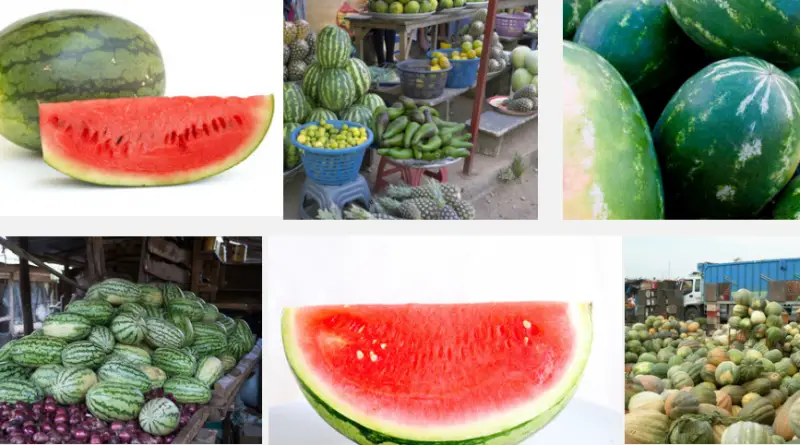How to Start Profitable Watermelon Farming Business in Nigeria 2025
Before we look into starting a watermelon business in Nigeria, let me quickly explain to you the descriptive aspect of the watermelon fruits in case you don’t know much about it and its origin.
Watermelon is an essential cucurbitaceous vegetable widely grown and consumed in most regions of Nigeria.
The crop is generally cultivated during November through April, depending on water availability. The fruit crop requires a hot dry climate with warmer days and cooler nights.
Although there are many varieties of watermelon, farmers prefer to cultivate hybrids as they command better prices due to their high productivity in yield and sweetness in taste.
Watermelon is an excellent dessert fruit and the juice makes a good refreshing and cooling beverage. It is an edible flesh that contains 92% water, 0.2% protein, 0.3% minerals, and 7% carbohydrates.
You will surely agree with me that it is one of the most consumed fruits in Nigeria. The reason behind this is not far-fetched owing to the good taste and the abundance of nutritional content which includes the presence of amino acids and citrulline (the body later converts it to arginine).
Having said all this, let’s discuss how to start up a watermelon business and how lucrative it can be. Every region of Nigeria supports the cultivation of watermelon farming.
At present, the northern region of Nigeria is responsible for the highest production of the fruit. The reason watermelon business is lucrative is that it requires low capital to start up and there is a high demand for it. Below are the necessary things to consider when starting up the business.
Do you own a business? Do you want to own a business?

Hot New Exclusive Training By A Professional Videographer Reveals 7 Amazing Secrets of Creating Stunning Product Videos That Can Make Huge Profits for Any Business in Nigeria...Using Just Your Smartphone!
YES, I WANT ACCESS TO THE EXCLUSIVE TRAINING FOR FREECapital
This is the major requirement for starting any business. You don’t need a lot of capital to start up a watermelon farm; the reason being that it is cost effective and easy to start up. The capital needed will solely depend on how large you want your farm to be. Listed below are the essential costs you will need money to cover.
- Purchase of farmland
- Money to get watermelon seeds (it is advisable to buy viable and disease-resistant seeds)
- Farm equipment (much equipment is not needed because manual labour can be used alternatively)
- Cost of labour (it is advisable to hire labourers since you’re targeting commercial production)
- Farm inputs (such as fertilizers, pesticides, herbicides).
There are no fixed costs for all the aforementioned expenses; the total budget can vary from one place to another and they are, in many cases, negotiable.
Related
- How to Start a Lucrative Business in Nigeria (Complete Guide)
- How to Start Profitable Uber and Taxify Business in Nigeria
- How to Start Profitable Charcoal Export Business in Nigeria
- How to Start Crude Oil Brokerage in Nigeria
- How to Start Import and Export Business in Nigeria
- How to Find Crude Oil Buyers and Sellers in Nigeria
Soil Requirement
Watermelon thrives best in a well-drained and not in water-logged soil with good air and water infiltration rates. Soil should be of 6 -7 PH. Liming can be done in case of low soil PH. It must also be noted that fine sand produces the highest watermelon when adequate fertilizer and water are added.
Soil and Land Preparation
Watermelon can be cultivated commercially on a wide variety of soils. Sandy loams have been proven to be the best for early crop while high productivity is recorded in loamy soils. Well-drained soil with high organic matter is best suited for cultivation. Land can be prepared by ploughing at right moisture content using a tractor or power tiller drawn plough to get the required soil tilt.
Do you own a business? Do you want to own a business?

Hot New Exclusive Training By A Professional Videographer Reveals 7 Amazing Secrets of Creating Stunning Product Videos That Can Make Huge Profits for Any Business in Nigeria...Using Just Your Smartphone!
YES, I WANT ACCESS TO THE EXCLUSIVE TRAINING FOR FREERecommended Varieties/Hybrids
Many varieties and hybrids of watermelon are made available by agricultural research institutes and private seed companies. Examples include Arka Yamato, Jyoti, and Augusta. Most commercial growers prefer Sugar Baby because it generates high yield and has good taste.
Sowing
Two different methods of sowing recommended are:
- Furrow method: Open furrows at a distance of 2-3 meters apart. Sow the seeds on either side of the furrows and allow the vines to trail on the ground. Two plants/ hills should be maintained. In a furrow plant to plant, spacing should be 0.75 to 1m.
- Pit method: Prepare pit of 60cm diameter and fill with a sufficient quantity of organic manure before sowing. Four plants/ pit should be maintained and pit to pit distance should be 2-3m.
Seed rate: Seed rate depends majorly on the variety or the hybrid. Usually, 3 kg/ha for small-seeded types and 5 kg/ha for large-seeded types are advisable. But for high yielding hybrids, the seed rate of 0.75 to 1kg is sufficient per hectare.
Seed treatment: Seeds with fungicide can be treated with Carbendazim @ 2g/kg of seed or Thiram @ 2g/kg of seed and are to be sowed immediately after treatment. Note that it is not advisable to combine fungicide treatment and biocontrol treatment together.
Post Planting Operations
The post planting operations of watermelon include:
- Weed Management
- Water Management
- Pruning
- Harvesting
1. Weed Management
Weed management spray, Butachlor @ 2kg/ha, after 3 days of sowing, removes the weeds by hand weeding after 15, 30 and 45 days of sowing.
2. Water Management
Watermelon needs to be irrigated at regular intervals of time as it thrives well when irrigated. Over-mulching is not recommended as it promotes excessive vegetative growth.
Watering of the watermelon fields should be stopped during ripening because it will negatively affect fruit quality and lead to fruit cracking. Water stagnation should be avoided during the pre-flowering, flowering and fruit development stage. Water the root zones only and not the vegetative growth, flowers, and fruits.
3. Pruning
Prune the excessive vine growth manually to restrict vegetative growth and promote a higher female to male flower ratio. If the apical shoot is pinched and 2-4 side shoots are allowed to grow, it gives significantly higher yield. Thin the fruits to retain only a maximum of 4-5 fruits per vine to improve fruit size and yield.
4. Harvesting
Harvesting of watermelon starts 30-40 days after flowering. Harvest patterns of watermelon are given below. You may use it as a guide.
Do you own a business? Do you want to own a business?

Hot New Exclusive Training By A Professional Videographer Reveals 7 Amazing Secrets of Creating Stunning Product Videos That Can Make Huge Profits for Any Business in Nigeria...Using Just Your Smartphone!
YES, I WANT ACCESS TO THE EXCLUSIVE TRAINING FOR FREE- Harvest the fruit when it produces heavy dull sound upon tapping.
- The maturity of the fruit is indicated when the fruit’s surface on the ground level produces a light yellow colour.
Marketing
Your harvest can be marketed to your target market area, which I believe you must have researched before venturing into the business. But one thing is sure; the demand for watermelon is always high.
Consider Starting Other Businesses in Nigeria
- How to Start a Lucrative Business in Nigeria (Complete Guide)
- How to Start Profitable Uber and Taxify Business in Nigeria
- How to Start Profitable Charcoal Export Business in Nigeria
- How to Start Crude Oil Brokerage in Nigeria
- How to Start Import and Export Business in Nigeria
- How to Find Crude Oil Buyers and Sellers in Nigeria
- How to Start a Home Cleaning Business in Nigeria
- How to Start a Profitable Plastic Recycling Business in Nigeria
- How to Start a Profitable Beans Farming Business in Nigeria
- How to Get Import and Export License in Nigeria
- How to Start a Profitable Fashion Business in Nigeria
- How to Start a Profitable Cucumber Business in Nigeria
- How to Start Egg Delivery Business in Nigeria




